Dell UltraSharp U2711: Quality has a Price
by Jarred Walton on January 22, 2010 2:00 AM EST- Posted in
- Displays
Dell U2711 Color Quality
We'll start with a look at the color quality of the U2711, broken down into two areas: Color gamut and color accuracy (i.e. Delta E). We'll start by explaining the former. Color gamut refers to the ability for a display to represent all of the colors in a defined selection of colors. In this case, we use the Adobe RGB standard to define the base gamut, and we measure the percentage of that standard that a display is able to cover - higher being better.
Delta E is the difference between a requested color and the color that actually appears on the display, with lower being better - i.e. the displayed color doesn't have a large delta relative to what was requested. If a display has perfect color accuracy, Delta E will be 0.0; in practice, anything less than 1.0 is nearly perfect and no one will notice the difference. A Delta E of 2.0 or less is the desired result after calibration, meaning no one color measures higher than 2.0 on our standard 24 color palette. Such a result would be fit for use in any professional imaging environment. Finally, while Delta E of around 4.0 is visible to the naked eye, it's really a question of reference points; if you don't have something better nearby and you're not going to print or view content on other media, a result where all colors measure 4.0 or less is very good.
So how does the U2711 do in these areas? First let's look at the charts, and then we'll discuss what they mean. We used the Graphics and Adobe RGB setting on the U2711, with brightness set at 36% (~200nits) and contrast at the default 50%.

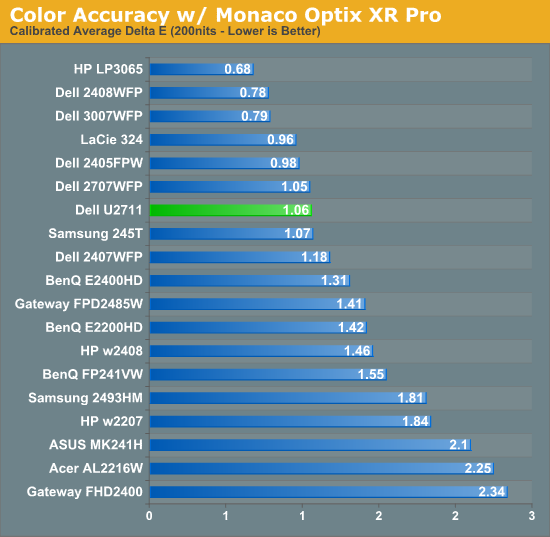
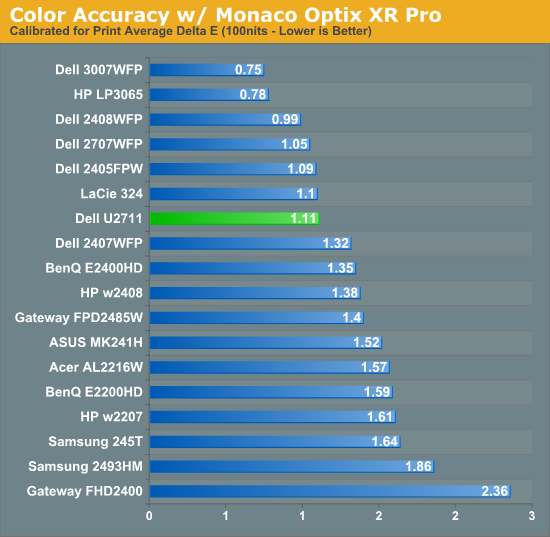
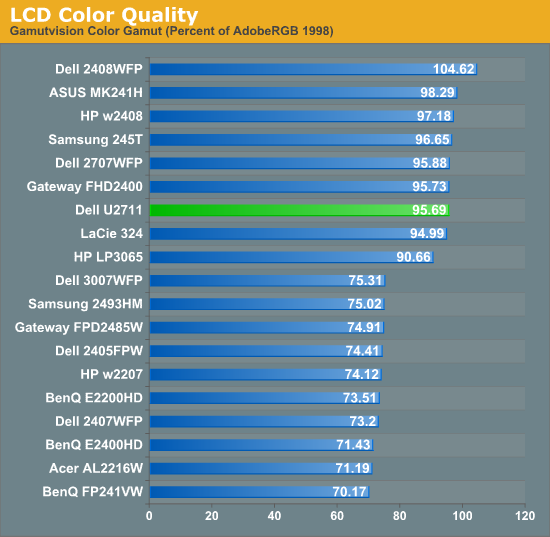
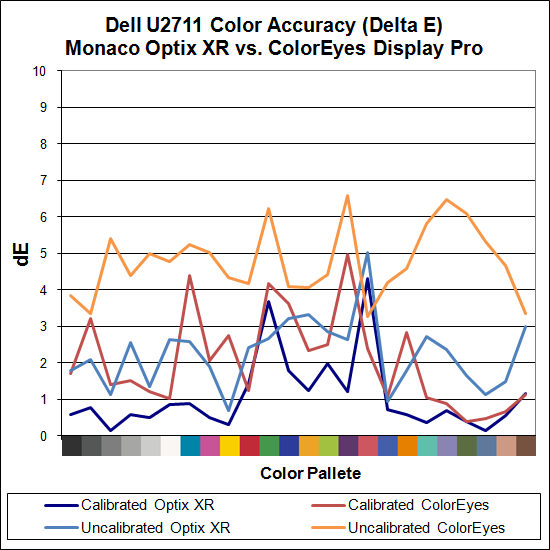
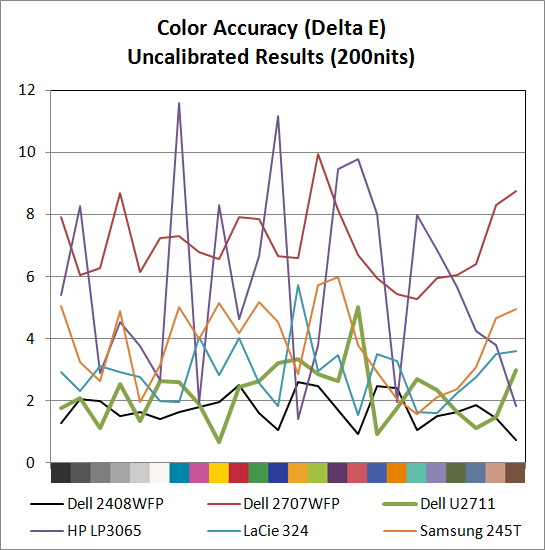
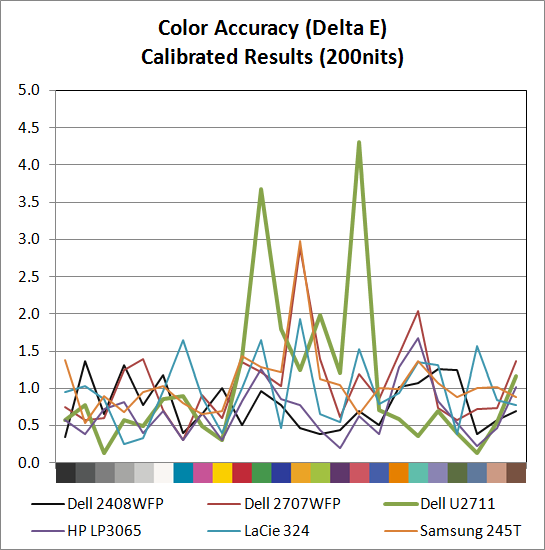
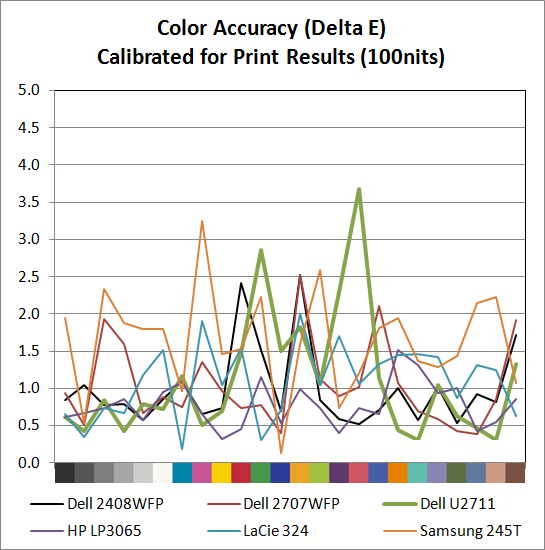
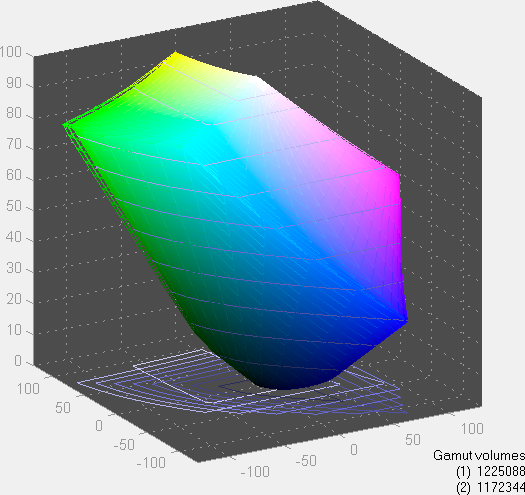
The U2711 scores extremely well in color gamut, and it achieves the 96% of Adobe RGB that Dell claims in their literature (not that most users would really notice the difference between any of the displays rated 90% to 105% - at least not after you eliminate the TN panels). Color accuracy on the other hand is a bit of a mixed bag. Dell ships a paper with test results showing the color calibration of each individual U2711, with the claim that the displays will have an average Delta E of less than 5.0 without any end-user calibration (when using the sRGB and Adobe RGB settings). Dell uses Minolta Color Analyzer CA210 and 32 test colors while we test with ColorEyes Display Pro and Monaco Optix XR Pro and 24 test colors, but our Monaco results confirm their claim. We're not sure why, but we continue to get better results using Optix XR Pro than with ColorEyes Display Pro.
As far as Optix is concerned, the U2711 achieves the rated Delta E of < 5.0 at just 2.24 without calibration, which is an excellent result. In fact the U2711 has no colors in the standard Gretag Macbeth 24 color palette score higher than 5.0 (and only reddish-pink scores a 5.0 measurement). The only LCD we've tested that did better is Dell's own 2408WFP (which also, interestingly enough, had an Adobe RGB color gamut of 105%). ColorEyes also gives an average Delta E of less than 5.0, but at 4.78 the score isn't nearly as remarkable, with nine color measurements well above 5.0. The uncalibrated (Monaco) results put the U2711 ahead of the HP LP3065, Dell 2707WFP, Samsung 245T, and LaCie 324 - and just about every other LCD we've tested.
Switch to the calibrated results and the U2711 doesn't impress quite as much relative to the competition. Monaco gives the U2711 an average Delta E of 1.06, which is great, but there are two results above 3.0 (the worst is reddish-pink again, this time at 4.31) compared to displays like the HP LP3065 where the highest measured Delta E is just 1.68. Dell's own 2707WFP, a three-year-old offering, also delivered a similar average Delta E but with only two colors above 2.0 (and still under 3.0). For a better LCD (i.e. not a TN panel), the results are really only slightly above average. It is possible different calibration software would achieve a better end result, but really we're talking about a "problem" that only the most demanding users are likely to ever notice.
Color Consistency
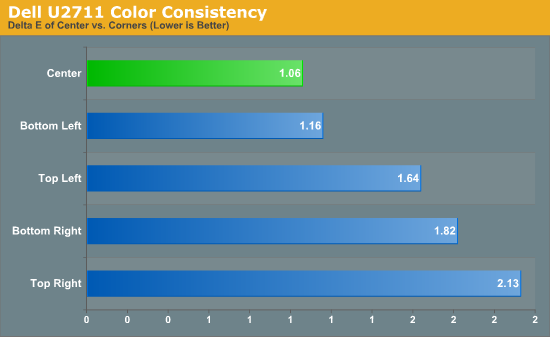
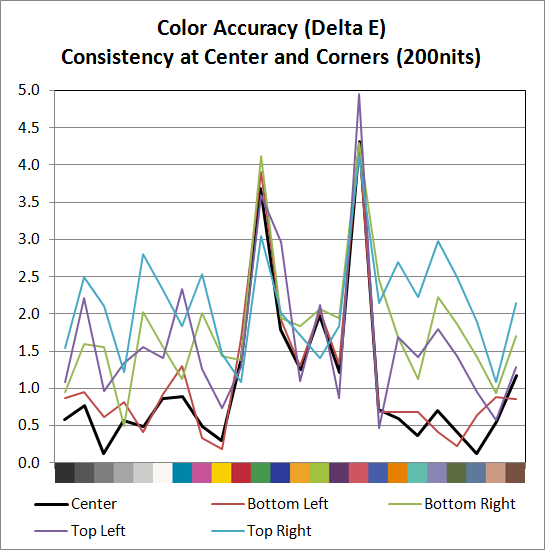
We added another test to try and measure the panel consistency across the entire surface. We measure Delta E at the center of the display, but what happens on the edges? To test this, we used the same profile generated in our best Delta E test result and measured Delta E again at the four corners. Most of the scores are similar, with a slight increase in average Delta E relative to the center measurement. The bottom-left corner is nearly identical to the center measurement, the top-left and bottom-right are a bit worse, and the top-right corner gets the overall worst result. While on the one hand we could say that the Delta E on the top-right is twice that of the center measurement, it's not a case of being "twice as bad". In fact, the color consistency is very good, and we didn't notice any "hot spots" are areas where the colors were clearly off relative to the rest of the LCD.










153 Comments
View All Comments
JarredWalton - Monday, January 25, 2010 - link
I've also tested with the i1 Display2 and achieved essentially the same results (within about 10% on Delta E and within about 2% on gamut). I'm not sure if the Spyder3 is better than both of those, but the i1D2 is pretty well regarded and I've read some stuff in the past where DTP-94 was regarded as one of the better colorimeters. I may play around with the latest version of ColorEyes again just to make sure nothing is wrong. I really don't want to have to invest in another colorimeter, though, since I already have three. :| It would be particularly odd for Spyder3 to be better considering Spyder2 wasn't regarded as being all that great and Spyder3 costs around half as much as the i1D2 or DTP94. But hey, price isn't necessarily a good indicator of quality. Heh.toyotabedzrock - Monday, January 25, 2010 - link
Any chance we will see a review on the U2410? I have heard of problems with it and would like to see your take on it.AngEviL - Sunday, January 24, 2010 - link
Hi Jared, can you please answer me this question ? I had a 22"1680x1050 monitor and I was very annoyed by the "sieve effect". Basically i saw the blackness between the pixels. For that reason mostly i upgraded to a 24" 1920x1200 TN panel lcd and i still spot very well the black between pixels and it is annoying me. Now you will ask how far i am standing from the monitor. I am at 2 thirds of a meter away, or 2 feet, and i really can't go any farther than that because the monitor becomes too small in my field of view.I know that the lower pixel pith will make the blackness between pixels less noticeable, but my question is how much less ? Also, is the proportional distance between pixels smaller compared to other models ? I'm just making this up, but let's say that on a 24" 1920x1200 monitor 90% of the screen space is pixels, and 10% is the black space between them. Does this Dell have less black space proportionally or it maintains the same ration, like 5% black space ?
I ask because i know that the "sieve effect" will be less noticeable on this Dell because of the lower pixel pitch... but how much less compared to a 24" 1920x1200 TN panel ? Thanks.
AngEviL - Sunday, January 24, 2010 - link
In case you think that the monitor i have has larger pixel spacing or something, i do see this sieve effect just as much on my 1440x900 17" laptop (from a normal viewing distance), and on my friend's laptops, as well and it is bothering me as much. Another reason why i ask is because i read somewhere that H-ISP (which i think this panel uses) has less proportional distance between pixels(more space is used up by the actual pixels and less by the blackness between them). I'm wondering if this is really true.JarredWalton - Monday, January 25, 2010 - link
You have better eyes than me, certainly. I can say on the U2711 (and on 30" LCDs), I really can't spot the red green and blue elements that make up white unless I get out a magnifying glass, and I certainly can't see the black between those elements. Well, I suppose I sort of can see the squares that make up the LCD, but that's about it. The U2711 is certainly smaller dots than other desktop LCDs, though.AngEviL - Monday, January 25, 2010 - link
Thanks for the answer.macforth - Monday, January 25, 2010 - link
An interesting article Jarrad. Clearly from the derth of discussion, screens are very important to us all. Although I don't feel that old, and enjoy gaming to the max, I clearly remember the days when there was no such thing as a visual display unit (as we called them when they were first used).Since those heady days in the late 60's we have sure come a long way from those green screens to that which is the subject of your article.
Surprisingly, having read all the post article discussion, no mention has been made of the new 120Hz screens. You did mention 60Hz at one point in the discussion.
I just built a nice gaming PC for a mate, and bought a new 120Hz screen to go with that. All I can say, it beats all the other screens in the house from 30" to 22" to an old 21CRT.......mind you when the CRT was in it's hayday, maybe similar. It is very impressive, and was nowhere near the cost of the sceen in your article.
I do hope that you, or maybe your (hopefully) new writer can have a crack at the new 120Hz movement in screens. Oh!.......the ones available round me (downunder) are 16:10, lol
Keep up the good work!.......
JarredWalton - Monday, January 25, 2010 - link
The big complaint with 120Hz displays is that they're all TN panels (as far as I'm aware). But, TN is often good enough for a lot of people, and it's a lot cheaper than IPS and *VA. I'm hoping to at least get *some* 120Hz LCD for testing in the not-too-distant future.mikeyakame - Sunday, January 24, 2010 - link
I couldn't find the panel type mentioned anywhere, but from what I recall this and the Apple 27" monitors both use the new LG-Phillips 27" H-IPS Panel, not S-IPS.JarredWalton - Sunday, January 24, 2010 - link
I couldn't get any report of the manufacturer; I used to get decent results from Astra32, but now the manufacturers have gotten smart and Dell writes their own name in the firmware. So this panel tells me it's a "Dell U2711". LOL.I don't think I called it an "S-IPS" anywhere; it's just *some* form of IPS, and whether that's H-IPS or S-IPS isn't hugely important. Given contrast is measured at 800:1 to 1000:1 (depending on brightness), H-IPS is entirely possible. But then, refinements to LG's S-IPS might accomplish the same thing.